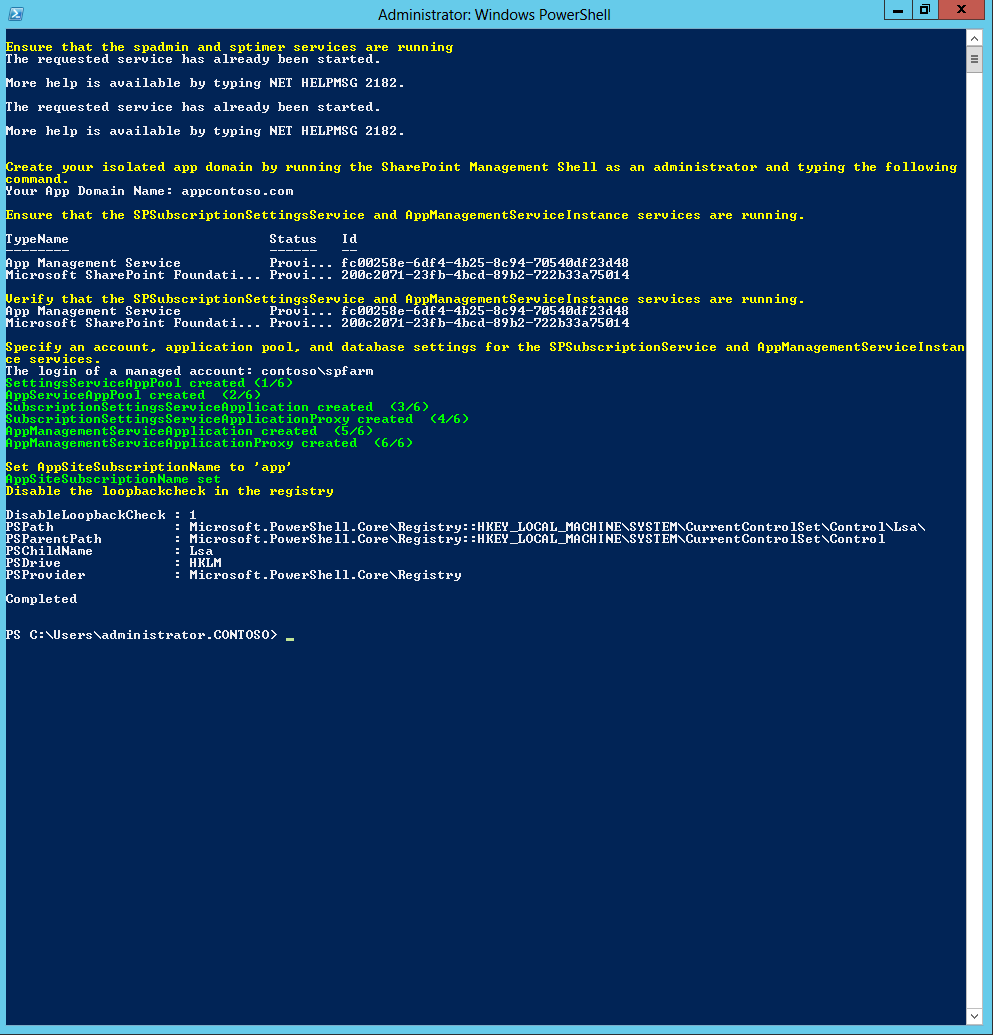Setting up your App domain for SharePoint 2013 via PowerShell
There is an excellent article on MSDN called “How to: Set up an on-premises development environment for apps for SharePoint.”
I’ve created a PowerShell script that runs all the required commands for you, please be sure that you run it as administrator.
The Disable of the loopback check in the registry is included.
# Check if the execution policy is set to Unrestricted
$policy = Get-ExecutionPolicy
if($policy -ne "Unrestricted"){
Set-ExecutionPolicy "Unrestricted"
}
# Check if current script is running under administrator credentials
$currentPrincipal = New-Object Security.Principal.WindowsPrincipal( [Security.Principal.WindowsIdentity]::GetCurrent() )
if ($currentPrincipal.IsInRole( [Security.Principal.WindowsBuiltInRole]::Administrator ) -eq $false) {
(get-host).UI.RawUI.Backgroundcolor="DarkRed"
clear-host
write-host "Warning: PowerShell is not running as an Administrator.`n"
exit
}
# Load SharePoint powershell commands
Add-PSSnapin "microsoft.sharepoint.powershell" -ErrorAction SilentlyContinue
cls
# Ensure that the spadmin and sptimer services are running
Write-Host
Write-Host "Ensure that the spadmin and sptimer services are running" -ForegroundColor Yellow
net start spadminv4
net start sptimerv4
# Create your isolated app domain by running the SharePoint Management Shell as an administrator and typing the following command.
Write-Host
Write-Host "Create your isolated app domain by running the SharePoint Management Shell as an administrator and typing the following command." -ForegroundColor Yellow
$appdomain = Read-Host "Your App Domain Name"
Set-SPAppDomain $appdomain
# Ensure that the SPSubscriptionSettingsService and AppManagementServiceInstance services are running
Write-Host
Write-Host "Ensure that the SPSubscriptionSettingsService and AppManagementServiceInstance services are running." -ForegroundColor Yellow
Get-SPServiceInstance | where{$_.GetType().Name -eq "AppManagementServiceInstance" -or $_.GetType().Name -eq "SPSubscriptionSettingsServiceInstance"} | Start-SPServiceInstance
# Verify that the SPSubscriptionSettingsService and AppManagementServiceInstance services are running
Write-Host
Write-Host "Verify that the SPSubscriptionSettingsService and AppManagementServiceInstance services are running." -ForegroundColor Yellow
Get-SPServiceInstance | where{$_.GetType().Name -eq "AppManagementServiceInstance" -or $_.GetType().Name -eq "SPSubscriptionSettingsServiceInstance"}
# Specify an account, application pool, and database settings for the SPSubscriptionService and AppManagementServiceInstance services
Write-Host
Write-Host "Specify an account, application pool, and database settings for the SPSubscriptionService and AppManagementServiceInstance services." -ForegroundColor Yellow
$login = Read-Host "The login of a managed account"
$account = Get-SPManagedAccount $login
$appPoolSubSvc = New-SPServiceApplicationPool -Name SettingsServiceAppPool -Account $account
Write-Host "SettingsServiceAppPool created (1/6)" -ForegroundColor Green
$appPoolAppSvc = New-SPServiceApplicationPool -Name AppServiceAppPool -Account $account
Write-Host "AppServiceAppPool created (2/6)" -ForegroundColor Green
$appSubSvc = New-SPSubscriptionSettingsServiceApplication –ApplicationPool $appPoolSubSvc –Name SettingsServiceApp –DatabaseName SettingsServiceDB
Write-Host "SubscriptionSettingsServiceApplication created (3/6)" -ForegroundColor Green
$proxySubSvc = New-SPSubscriptionSettingsServiceApplicationProxy –ServiceApplication $appSubSvc
Write-Host "SubscriptionSettingsServiceApplicationProxy created (4/6)" -ForegroundColor Green
$appAppSvc = New-SPAppManagementServiceApplication -ApplicationPool $appPoolAppSvc -Name AppServiceApp -DatabaseName AppServiceDB
Write-Host "AppManagementServiceApplication created (5/6)" -ForegroundColor Green
$proxyAppSvc = New-SPAppManagementServiceApplicationProxy -ServiceApplication $appAppSvc
Write-Host "AppManagementServiceApplicationProxy created (6/6)" -ForegroundColor Green
# Specify your tenant name
write-host
Write-Host "Set AppSiteSubscriptionName to 'app'" -ForegroundColor Yellow
Set-SPAppSiteSubscriptionName -Name "app" -Confirm:$false
Write-Host "AppSiteSubscriptionName set" -ForegroundColor Green
# Disable the loopbackcheck in the registry
Write-Host "Disable the loopbackcheck in the registry" -ForegroundColor Yellow
New-ItemProperty -Path "HKLM:\SYSTEM\CurrentControlSet\Control\Lsa\" -Name "DisableLoopbackCheck" -PropertyType DWord -Value 1
Write-Host "Completed"
create an isolated app domain.ps1
Comments
Anonymous
January 14, 2013
I did all the other settings like the other article that you mentioned. But you have got the disable loop back. When I applied that, it works like charm. Thanks a lot for nice and neat script.Anonymous
January 15, 2014
Interesting and helpful post. Thanks Tom!Anonymous
September 10, 2014
This script is not working for me. When I try to set the subscription service application, I keep getting an error that the parameter is null. And I get errors that the database already exists. Been at this for days. Any help would be appreciated.Anonymous
April 05, 2015
Dears, I don't have application domain. What shall do. What you mean by App Domain, Is it a purchased domain? Confused. Please help me. Thanks in Advance.Anonymous
May 08, 2015
It need not be purchased domain. on your development server use domain like "companyname.com" or indeed any name of your interest. @somAnonymous
May 08, 2015
Thanks Tom for your efforts to write PS script. I too have used the same link that you mentioned for setting up my environment a couple of days back. I am planning to automate the steps and your write up saves my time.Anonymous
June 25, 2015
Before you run this script you need to ensure a managed account is created in the SharePoint configuration. I followed the answer described here sharepoint.stackexchange.com/.../how-to-get-all-managed-accounts-and-create-a-new-one-using-powershell-in-sharepo
